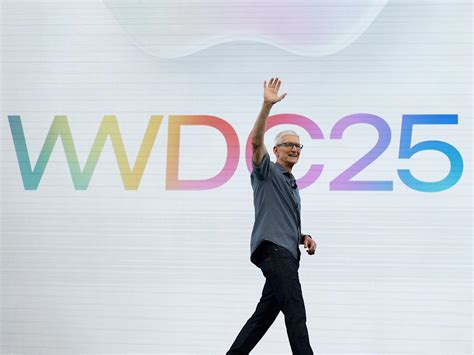
Apple’s Worldwide Developers Conference (WWDC) showcased significant software enhancements across its ecosystem, including iOS 18, iPadOS 18, and macOS Sequoia, focusing on customization, connectivity, and productivity improvements. While the event emphasized these software upgrades, the absence of a groundbreaking AI reveal left some observers wanting.
Apple’s WWDC 2024: Software Takes Center Stage, AI Remains Subdued
Apple’s Worldwide Developers Conference (WWDC) 2024 placed a heavy emphasis on substantial software updates across its core product lines, including the iPhone, iPad, and Mac. The event, held this week, unveiled iOS 18, iPadOS 18, and macOS Sequoia, all featuring a range of new functionalities and improvements designed to enhance user experience and productivity. Notably absent, however, was a splashy, headline-grabbing announcement in the realm of artificial intelligence, an area where competitors have been making significant strides.
The keynote address focused primarily on the depth and breadth of the software enhancements, showcasing Apple’s commitment to refining its existing platforms rather than introducing entirely new product categories or AI-driven innovations. The updates emphasized user customization, seamless cross-device connectivity, and productivity enhancements.
iOS 18: Personalization and Enhanced Communication
iOS 18 brings a new level of personalization to the iPhone experience. Users will now have greater control over the placement of apps and widgets on their home screen, allowing for a more customized and aesthetically pleasing layout. Control Center has been redesigned, providing quick access to frequently used settings and controls. Users can now customize the buttons at the bottom of the lock screen, adding shortcuts to their favorite apps or features.
A significant update is the redesigned Photos app, which aims to simplify photo organization and make it easier for users to find specific memories. The new design features a streamlined interface with improved search capabilities and enhanced sorting options.
Communication also received a boost with iOS 18. Messages now supports RCS (Rich Communication Services), bringing features like read receipts, typing indicators, and higher-quality media sharing to conversations with Android users. This move aligns Apple with industry standards and enhances the messaging experience for users on both platforms.
Mail also gets smarter with on-device AI processing to categorize emails.
iPadOS 18: Leveraging Apple Pencil and Multitasking Enhancements
iPadOS 18 builds upon the iPad’s strengths as a versatile productivity tool. The update focuses on enhancing the Apple Pencil experience and improving multitasking capabilities.
The Scribble feature, which allows users to handwrite text that is automatically converted to typed text, has been enhanced with improved accuracy and support for more languages. New Apple Pencil tools and effects have been added, allowing users to create more expressive and detailed drawings and annotations.
Multitasking on the iPad gets a significant boost with new window management features and improved Stage Manager functionality. Users can now resize and reposition windows more easily, making it easier to work with multiple apps simultaneously.
macOS Sequoia: iPhone Mirroring and Gaming Improvements
macOS Sequoia introduces several features designed to improve productivity and connectivity between Apple devices. One of the most notable additions is iPhone Mirroring, which allows users to control their iPhone directly from their Mac. This feature enables users to send texts, answer calls, and access iPhone apps without having to pick up their phone.
Gaming also receives a boost with macOS Sequoia. Apple is working to bring more AAA titles to the Mac platform, and the update includes new gaming APIs and optimization tools designed to improve performance and graphics quality. The company highlighted its collaboration with game developers to bring popular titles to the Mac.
Safari also receives a makeover, utilizing AI to automatically highlight important information on a webpage.
The AI Absence: A Deliberate Strategy?
While the software updates unveiled at WWDC 2024 were substantial, the absence of a major AI announcement was notable. Competitors like Google and Microsoft have been aggressively pursuing AI-driven features and integrations across their products, leaving some observers wondering about Apple’s strategy.
According to the Yahoo Finance article, “Apple’s AI strategy has been much more under the hood and focused on making its existing services better, rather than some splashy reveal of a new chatbot or image generator.” This suggests that Apple is taking a more measured and deliberate approach to AI, focusing on integrating it into existing features and services rather than launching entirely new AI-powered products.
This approach may reflect Apple’s commitment to user privacy and data security. The company has historically been cautious about collecting and using user data, and it may be hesitant to embrace AI technologies that rely heavily on data collection.
“In contrast, Apple has focused on features like on-device processing to improve privacy and security,” the article notes. This suggests that Apple is prioritizing privacy over flashy AI features, opting for AI implementations that minimize data collection and processing on remote servers.
Industry Reactions and Analysis
The response to Apple’s WWDC 2024 has been mixed. Some analysts have praised the company’s focus on refining its existing platforms and improving user experience. Others have expressed disappointment at the lack of a major AI announcement, arguing that Apple is falling behind its competitors in this critical area.
“The lack of a groundbreaking AI reveal left some observers wanting,” according to the Yahoo Finance article. This sentiment reflects the growing expectation that Apple will need to make a more significant push into AI in order to remain competitive in the long term.
However, Apple’s approach may be more strategic than it appears. By focusing on integrating AI into existing features and services, the company may be able to deliver a more seamless and intuitive AI experience that is less disruptive to users’ workflows.
Looking Ahead
While WWDC 2024 did not feature a major AI announcement, it is likely that Apple is continuing to invest heavily in AI research and development. The company may be waiting for the technology to mature and for its AI implementations to be more aligned with its values of privacy and security before making a more public push.
In the meantime, Apple is focused on delivering substantial software updates that improve user experience and productivity across its ecosystem. The updates unveiled at WWDC 2024 demonstrate Apple’s commitment to refining its existing platforms and delivering value to its users.
The company’s long-term AI strategy remains to be seen, but it is clear that Apple is taking a more deliberate and measured approach than some of its competitors. Whether this approach will ultimately prove successful remains to be determined, but it reflects Apple’s unique values and its commitment to user privacy and security.
The focus on software, rather than hardware, could also indicate a shift in strategy, prioritizing user experience and retention through iterative improvements. This could be seen as a response to a maturing smartphone market and a desire to maximize the value of its existing user base.
WWDC 2024: A Deeper Dive into Key Announcements
Beyond the overarching themes of personalization, productivity, and connectivity, WWDC 2024 featured a multitude of specific announcements that warrant a closer look. These announcements detail the finer points of the software updates and provide a more complete picture of Apple’s vision for its ecosystem.
-
Enhanced Privacy Features: Apple continues to prioritize user privacy with new features designed to protect user data. Mail Privacy Protection has been enhanced to prevent senders from tracking email opens and IP addresses. Safari now includes Intelligent Tracking Prevention, which helps to block cross-site tracking.
-
Accessibility Improvements: Apple has also made significant improvements to accessibility features across its platforms. Voice Control, which allows users to control their devices using their voice, has been enhanced with improved accuracy and support for more languages. Live Captions, which automatically generate captions for audio content, are now available in more languages and can be customized to suit individual needs.
-
Developer Tools and Technologies: WWDC is also an important event for developers, and Apple used the opportunity to announce new tools and technologies designed to make it easier for developers to create and deploy apps for its platforms. Swift, Apple’s programming language, has been updated with new features and improvements. Xcode, Apple’s integrated development environment, has been enhanced with new debugging and profiling tools.
-
On-Device Intelligence: Apple is increasingly leveraging on-device processing to improve performance, privacy, and security. Many of the new features announced at WWDC 2024 rely on on-device intelligence, including image recognition, natural language processing, and machine learning. This approach allows Apple to deliver AI-powered features without having to send user data to remote servers.
-
Spatial Computing Updates: While not a primary focus, WWDC 2024 did include some updates related to Apple’s spatial computing efforts. The company showcased new apps and experiences for the Apple Vision Pro, its mixed reality headset. Apple is also working to make it easier for developers to create spatial experiences using its existing development tools and technologies.
The Future of Apple’s Ecosystem: A Focus on Integration and Refinement
WWDC 2024 made it clear that Apple is focused on integrating its hardware and software ecosystems even more tightly. Features like iPhone Mirroring on macOS Sequoia and the enhanced cross-device capabilities in iOS 18 and iPadOS 18 demonstrate Apple’s commitment to creating a seamless user experience across all of its devices.
The company is also focused on refining its existing platforms and improving user experience. The updates announced at WWDC 2024 are not revolutionary, but they are substantial and address many of the pain points that users have been experiencing.
This approach may be seen as a sign that Apple is maturing as a company. Rather than constantly chasing the next big thing, Apple is focused on making its existing products and services better. This strategy may not generate as much buzz as a groundbreaking new product announcement, but it is likely to be more sustainable in the long term.
The Impact on Consumers and Developers
The software updates announced at WWDC 2024 are likely to have a significant impact on both consumers and developers. Consumers will benefit from the improved user experience, enhanced features, and increased privacy and security. Developers will benefit from the new tools and technologies that make it easier to create and deploy apps for Apple’s platforms.
The move to RCS in Messages is a particularly significant development for consumers. This will finally bring parity to messaging between iOS and Android devices, eliminating many of the frustrations that users have experienced in the past.
The improvements to accessibility features are also noteworthy. Apple has a long history of prioritizing accessibility, and the updates announced at WWDC 2024 demonstrate its continued commitment to making its products and services accessible to everyone.
For developers, the new Swift features and Xcode enhancements will make it easier to create high-quality apps for Apple’s platforms. The company is also working to make it easier for developers to create spatial experiences for the Apple Vision Pro.
Frequently Asked Questions (FAQ)
-
What were the major announcements at Apple’s WWDC 2024?
The major announcements included iOS 18 with enhanced customization and RCS support, iPadOS 18 with improved Apple Pencil integration and multitasking, and macOS Sequoia with iPhone Mirroring and gaming improvements. Significant updates to privacy features and developer tools were also unveiled.
-
Why was there no major AI announcement at WWDC 2024?
Apple appears to be taking a more measured approach to AI, focusing on integrating AI into existing features and services while prioritizing user privacy and security. The company seems to be opting for on-device processing to minimize data collection and processing on remote servers.
-
What is iPhone Mirroring in macOS Sequoia?
iPhone Mirroring allows users to control their iPhone directly from their Mac. Users can send texts, answer calls, and access iPhone apps without having to pick up their phone. This enhances connectivity and productivity.
-
What is RCS support in iOS 18, and why is it important?
RCS (Rich Communication Services) support in iOS 18 brings features like read receipts, typing indicators, and higher-quality media sharing to conversations with Android users. This aligns Apple with industry standards and enhances the messaging experience for users on both platforms.
-
How will the new software updates impact developers?
The new developer tools and technologies, including Swift updates and Xcode enhancements, will make it easier for developers to create and deploy high-quality apps for Apple’s platforms. The company is also supporting the creation of spatial experiences for the Apple Vision Pro.
The Strategic Implications of Apple’s Approach
Apple’s strategic decision to downplay a massive, singular AI reveal at WWDC 2024 has wider implications beyond immediate product announcements. It suggests a long-term vision where AI is subtly woven into the fabric of the user experience, rather than being a standalone, attention-grabbing feature. This approach can be interpreted in several ways:
-
Emphasis on User Experience Consistency: Apple has always prioritized a seamless and intuitive user experience. Integrating AI discreetly ensures that users can benefit from its capabilities without being overwhelmed or feeling like they are constantly interacting with an artificial intelligence. This aligns with Apple’s history of making complex technologies accessible and user-friendly.
-
Data Privacy as a Competitive Advantage: In an era where data privacy is a growing concern, Apple’s commitment to on-device processing and minimal data collection can be a significant competitive advantage. By processing data locally, Apple reduces the risk of data breaches and enhances user trust. This can be particularly appealing to privacy-conscious consumers.
-
Iterative Development and Gradual Integration: Apple’s measured approach to AI may reflect a strategy of iterative development and gradual integration. Rather than launching a fully-fledged AI product, Apple may be opting to introduce AI capabilities incrementally, gathering user feedback and refining its algorithms over time. This allows for a more controlled and adaptable development process.
-
Focus on Practical Applications: While competitors may be focused on developing flashy AI technologies like chatbots and image generators, Apple appears to be more interested in practical applications of AI that can improve user productivity and efficiency. Features like smarter email categorization, enhanced photo organization, and improved voice control demonstrate this focus on utility.
-
Building a Foundation for Future AI Advancements: Apple’s current AI efforts may be laying the groundwork for more significant AI advancements in the future. By focusing on on-device processing and data privacy, Apple is building a foundation that can support more sophisticated AI applications while mitigating the risks associated with data collection and processing.
Contrasting Approaches: Apple vs. Competitors
To fully understand Apple’s strategy, it is helpful to compare it to the approaches of its competitors, particularly Google and Microsoft. These companies have been aggressively pursuing AI-driven features and integrations across their products, often prioritizing innovation and market share over privacy and user experience.
-
Google: Google has invested heavily in AI research and development, launching a variety of AI-powered products and services, including Google Assistant, Google Photos, and Bard. Google’s approach is characterized by a focus on data collection and cloud-based processing. This allows Google to leverage vast amounts of data to train its AI algorithms and deliver personalized experiences. However, it also raises concerns about data privacy and security.
-
Microsoft: Microsoft has also made significant strides in AI, integrating AI capabilities into its core products like Windows, Office, and Azure. Microsoft’s approach is characterized by a focus on enterprise applications and cloud-based services. The company has partnered with OpenAI to integrate its GPT models into its products, offering features like AI-powered code completion and natural language processing. Like Google, Microsoft relies heavily on data collection and cloud-based processing.
In contrast to these approaches, Apple is taking a more cautious and deliberate path. The company is prioritizing user privacy, on-device processing, and practical applications of AI. While this may mean that Apple is not launching as many flashy AI products as its competitors, it may also mean that Apple is building a more sustainable and user-friendly AI ecosystem in the long term.
The Role of Hardware in Apple’s AI Strategy
While WWDC 2024 focused primarily on software, it is important to recognize the crucial role that hardware plays in Apple’s AI strategy. Apple designs its own chips, including the A-series and M-series processors, which are optimized for machine learning tasks. These chips enable Apple to perform AI processing on-device, without having to send data to remote servers.
Apple’s hardware expertise gives it a significant advantage in the AI space. The company can design its chips to meet the specific needs of its AI algorithms, optimizing performance and efficiency. This allows Apple to deliver AI-powered features that are both powerful and energy-efficient.
Furthermore, Apple’s control over its hardware and software ecosystems allows it to create a more seamless and integrated AI experience. The company can optimize its software to take full advantage of its hardware capabilities, delivering AI features that are more responsive and intuitive.
The Importance of Context and User Trust
Apple’s measured approach to AI also reflects a deep understanding of the importance of context and user trust. The company recognizes that AI is not a one-size-fits-all solution and that users are more likely to embrace AI features that are relevant to their needs and respectful of their privacy.
By focusing on practical applications of AI and prioritizing user privacy, Apple is building trust with its users. This trust is essential for encouraging users to adopt AI features and for ensuring that AI is used in a responsible and ethical manner.
Apple’s emphasis on context also reflects a recognition that AI is most effective when it is integrated seamlessly into existing workflows. By focusing on features that enhance user productivity and efficiency, Apple is making AI a valuable tool for its users, rather than a disruptive force.
The Long-Term Vision for Apple’s Ecosystem
WWDC 2024 provided a glimpse into Apple’s long-term vision for its ecosystem. The company is focused on creating a seamless and integrated experience across all of its devices, powered by software that is both powerful and user-friendly.
AI is playing an increasingly important role in this vision. Apple is using AI to enhance its existing features and services, making them more intelligent and responsive. The company is also exploring new applications of AI that can improve user productivity and efficiency.
While Apple’s approach to AI may be more cautious and deliberate than that of its competitors, it is ultimately more aligned with the company’s values of privacy, security, and user experience. By focusing on these values, Apple is building a sustainable and user-friendly AI ecosystem that can benefit its users for years to come.
In conclusion, while the absence of a groundbreaking AI reveal at WWDC 2024 might have disappointed some observers, it underscores Apple’s commitment to a strategic, privacy-focused, and user-centric approach to AI integration. This involves refining existing platforms, prioritizing on-device processing, and ensuring AI enhancements are both practical and seamlessly woven into the Apple ecosystem, setting it apart from competitors prioritizing rapid AI deployment at the potential expense of user privacy and experience. This measured approach may ultimately prove more sustainable and aligned with Apple’s long-term vision.









